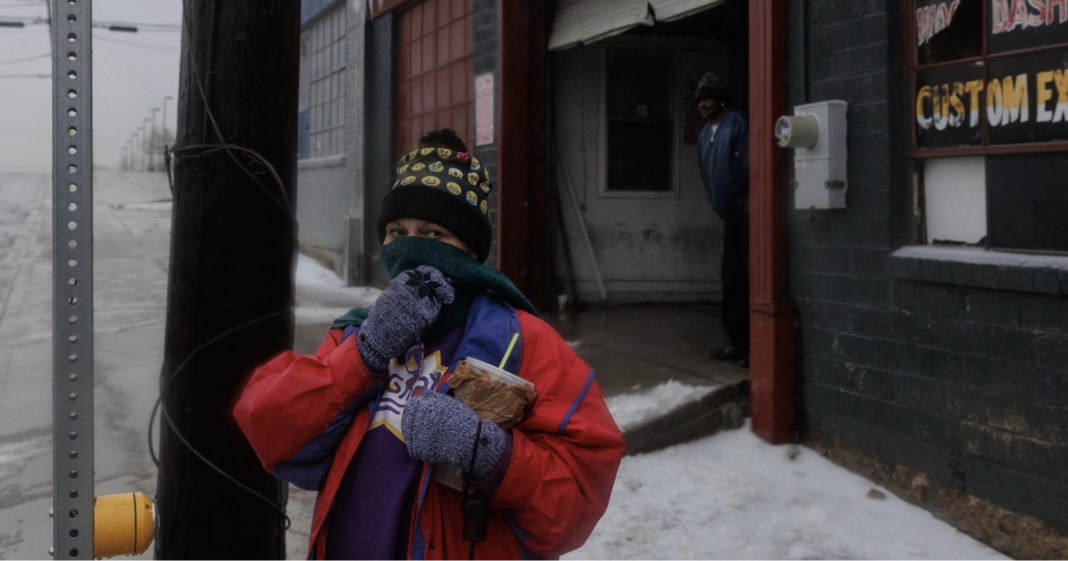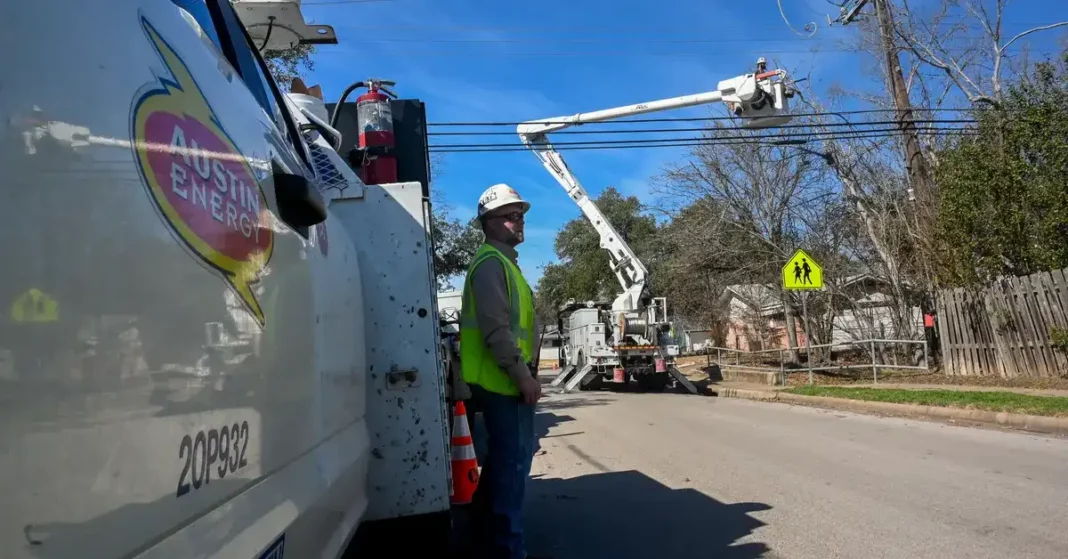Two years after a winter storm killed 246 people and left millions of Texans without electricity, Texas cities once again buckled under a menacing winter storm.
Freezing temperatures and ice storms pushed large portions of the state to a standstill this week. Many school districts shut down through at least Thursday as ice made roads and bridges in Dallas and Austin nearly impossible to traverse. Heavy ice brought down power lines all over Austin, prompting widespread power outages in the capital city of the nation’s second-most-populous state. Hundreds of thousands of businesses and households across Central and East Texas remained without power on Thursday as utility crews worked nonstop to repair downed power lines.
Unlike in February 2021 when the state’s electric grid nearly collapsed, this week’s outages were caused by localized issues, such as power lines downed by fallen trees. Still, the weather ultimately caused major disruptions and closures, leaving Texans wondering whether the rapidly growing state is fit to handle extreme weather.
Ice storms are common occurrences in Texas. John Nielsen-Gammon, the state’s climatologist, said that most areas of Texas north of Interstate 10 — or more than half of the state — average at least one day of freezing rain a year. The Texas Panhandle gets around three days of freezing rain per year.
Other extreme weather events, such as short, heavy bouts of precipitation and very hot days, are becoming increasingly common because of climate change.
But much of Texas’ infrastructure was not built to sustain such extreme cold weather. And local governments historically have not prepared for winter weather — in large part due to the costs. However, experts this week said what happened in Texas is fresh evidence that cities and states across the U.S. must rethink how they prepare for all sorts of weather-related emergencies.
Strategies to better prepare cities — large and small — can run the gamut from burying power lines, redeploying emergency response units and keeping trees trimmed, experts told The Texas Tribune.
“When we talk about adaptation, when we talk about resilience, what it means is that day to day, it costs more money to do that,” said Jeffrey Schlegelmilch, director of the National Center for Disaster Preparedness at Columbia University. “Now, it saves it in the long run. It saves it both in terms of economic loss as well as lives and livelihoods. But that [cost] is unavoidable.”
But implementing those ideas can be costly, leaving local elected officials presiding over limited budgets to figure out how much to spend — and how to sell the expense to the public.
“You need to analyze how much you’re going to spend on some things that might be [needed on] a rare occasion,” Austin Mayor Kirk Watson said. “You’re not going to want to act like you’re Buffalo, New York. You’re going to want to try to figure out what the possibilities are and what the costs are and then weigh the costs.”
“It’s very expensive to be cheap”
Increasingly, Southern cities more accustomed to dealing with extreme heat are figuring out how to deal with extreme cold — while the reverse is true for Northern cities.
The challenge for city and state leaders is to decide how much money to invest in preparing for winter weather that only occurs once or twice a year, on average.
State Rep. Erin Zwiener, a Democrat from Driftwood, whose home had been without power for four hours Thursday morning, floated the idea of using part of the state’s nearly $33 billion surplus on infrastructure to lessen the effects of severe winter storms — like buying more trucks to de-ice freezing roads.
“Maybe we’re only going to pull them out twice a winter,” Zwiener said, referring to the truck idea. “But I think that’s worth it for people to be able to safely reach hospitals, for people to be able to safely move to a place that does have power and for our power crews to be able to reach the lines in a reasonable amount of time they need to repair them.”
Although there is not strong evidence as to how climate change affects ice storms in Texas, climate experts said the storms nonetheless expose weaknesses in the state’s infrastructure.
“One thing [Winter Storm] Uri showed us is how vulnerable we are to any weather event that’s even a little bit outside of our normal operating conditions,” said Andrew Dessler, a climate scientist and the director for the Texas Center for Climate Studies at Texas A&M. “Just a few degrees outside of that, and things go to hell very quickly.”
A half an inch of ice or more is the technical definition of an ice storm, meteorologists said, but public safety impacts begin well before that. Even a quarter-inch of ice accumulation can cause power lines to go down, and tree limbs weighed down by ice can also fall onto power lines or equipment and result in outages.
Unlike northern cities like Chicago and New York, Texas’ largest cities weren’t built with severe winter weather in mind — and historically have not prioritized preparedness in case of a winter disaster.
“It’s tough to go backward once the infrastructure is already built,” said Dallas assistant emergency management coordinator Travis Houston.
After the 2021 storm, legislators passed a law requiring power companies to “weatherize” their facilities. But power transmission and distribution infrastructure is still not fully equipped to handle extreme weather. Whereas Midwestern and northeastern states tend to bury their power lines below the ground, for example, the majority of the state’s power lines are above ground and therefore susceptible to falling tree limbs.
At least one Austin City Council member already called on the city to bury its power lines.
Doing so would be very expensive, Austin Energy general manager Jackie Sargent said during a Thursday press conference — likely costing billions of dollars. It’s easier to bury power lines in new developments but is costly and difficult in existing neighborhoods. Burying power lines also makes it more difficult to maintain them and pinpoint a break in the line, Sargent said.
Michael Webber, an energy resources professor at the University of Texas at Austin, said burying power lines underground would be more reliable and may be worth the cost in the long run.
“We’re cheap,” Webber said. “And it’s very expensive to be cheap.”
Oncor, Texas’ largest transmission and distribution electric company, does have some underground power lines in downtown areas, according to company spokesperson Kerri Dunn. Individual customers can also in some cases have the power lines outside their home buried below ground, though they would usually bear the cost of doing so.
In addition to being more expensive, burying power lines also makes it more challenging to conduct repairs.
“When you do have an outage, we can look up at the sky and see if there’s something wrong with our equipment,” Dunn said. “When you’re going underground, you’re having to get folks underground into harder-to-reach areas.”
Despite the potential cost, Watson said Austin shouldn’t immediately dismiss the idea — and should consider it as part of a broader review of how to prepare Austin for future winter storms.
“I think the public deserves that to be looked at in a thoughtful way,” Watson said.
One of the factors that contributed to Austin’s blackout this week: trees.
Live oaks, ashe junipers and cedar elms alike cracked under the pressure of ice, taking the power lines down with their branches.
“Having a rigorous and ongoing tree-trimming effort to continually keep up with — they call it vegetation management — is a key contributor to providing highly reliable electricity service,” said Beth Garza, senior fellow with R Street Institute and an energy expert.
Power utility companies have plans to manage trees and other plants near power lines. But in some cases, the public protests the tree maintenance done by utilities. During a press conference Thursday, Austin Energy officials asked residents to be more cooperative when they come to prune.
“We want to be respectful of the trees and the value they bring to our communities,” Dunn said. “But it’s still very important for us to make sure we’re performing that trimming from a safety standpoint. So it’s a careful balance that we have to do.”
“Grinding to a halt”
Some of Texas’ smaller cities — including Amarillo, which sees much cooler weather than the rest of the state — have found ways to better prepare for weather emergencies.
“Whether it destroys the power grid because of the lines down, or if you’re unable to get emergency vehicles through places, ice storms are just the bane of any city’s existence,” said Paul Harpole, a former mayor of Amarillo.
The city has worked for years on disaster preparedness. Amarillo increased the number of emergency weather sirens, retrofitted dump trucks to clear snow and can now create emergency shelters at its civic center, which can be set up with showers, food and medical supplies for a makeshift shelter overnight if need be.
Additionally, several firehouses have been repositioned in Amarillo to cover more areas.
In East Texas, where freezing temperatures are less common, disaster preparedness is often conducted regionally. The East Texas Council of Governments, which serves 14 counties, has an alert notification system funded by the state. The council’s public safety director, Stephanie Heffner, also attends weekly phone calls with the Texas Division of Emergency Management to keep up to date on impending weather issues.
After the 2021 freeze, some smaller cities within East Texas worked with the council to learn how to better equip themselves for extreme weather, including by preparing their generators and scheduling preparedness exercises for first responders.
“We send lots of notifications throughout the region so that folks know that no matter what comes up, they can call us,” Heffner said. “Even if we are not the right department, we will point them in the right direction.”
Other parts of the state showed fewer signs of the struggles that vexed them two years ago.
The Dallas-Fort Worth region had relatively few power outages compared with Austin and generally fared better than Austin — in part because of luck in weather patterns, said Houston, the Dallas emergency official.
Dallas was prepared for the worst, Houston said. In February 2021, sweeping power outages knocked out the power at city facilities like libraries and recreation centers that had been set up as warming centers. This time, the city had backup generators ready to go at recreational centers that had been set up as warming centers in advance.
And while the lights mostly stayed on through North Dallas, emergency workers responded to hundreds of car crashes as drivers navigated icy roads. Social media captured dozens of cars trapped or sliding across highways and overpasses. Adam Hammonds, a Texas Department of Transportation spokesperson, said the agency in recent years has bolstered its stores of brine and salt to treat roadways in order to have enough to cover longer winter storms.
And after several days closed, Dallas Independent School District students will return with a delayed start time Friday. Fort Worth Independent School District students, however, will stay home after district officials decided to remain closed.
“It is jarring when you take a step back and look at a system and economy — not even just the city of Dallas, but just North Texas and the (Dallas-Fort Worth) metroplex as a whole — that something like this can send everything kind of grinding to a halt,” Houston said.
This story originally appeared on the Texas Tribune. To read this article in its original format, click here.








